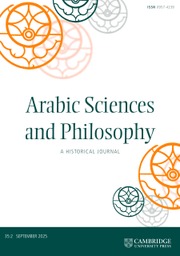Article contents
A Contribution by al-Qūhī to Geometrical Analysis
Published online by Cambridge University Press: 22 May 2002
Abstract
The development of geometrical analysis in the 10th century was partly inspired by the reception of the works of Apollonius, which Arab mathematicians translated as early as the preceding century. Al-Qūhī contributed to this development by writing several collections of problems dealing with Apollonian themes and solved by the method of analysis; however, it seems that they do not all occupy the same place in his work. The author gives here the edition, translation, and mathematical commentary of a short work, entitled The determination of two straight lines from a point along a known angle, which presents the particularity of providing problems as geometrical lemmas to other studies. Indeed, al-Qūhī uses two of these lemmas in more complex constructions which belong to his Treatise on the art of the astrolabe. In this same treatise on the astrolabe, as well as in his Treatise on the perfect compass, this scholar also uses as lemmas several problems solved in another of his works, entitled The generation of points on straight lines according to ratios of which the terms are surfaces. This work is unfortunately lost, and all that remains of it are the traces which subsist in other treatises in which it has been used. This study seems to be necessary if one wishes to understand the organization of the work of al-Qūhī, a mathematician of the first rank who was representative of his time.
- Type
- Research Article
- Information
- Copyright
- © 2002 Cambridge University Press
- 2
- Cited by


